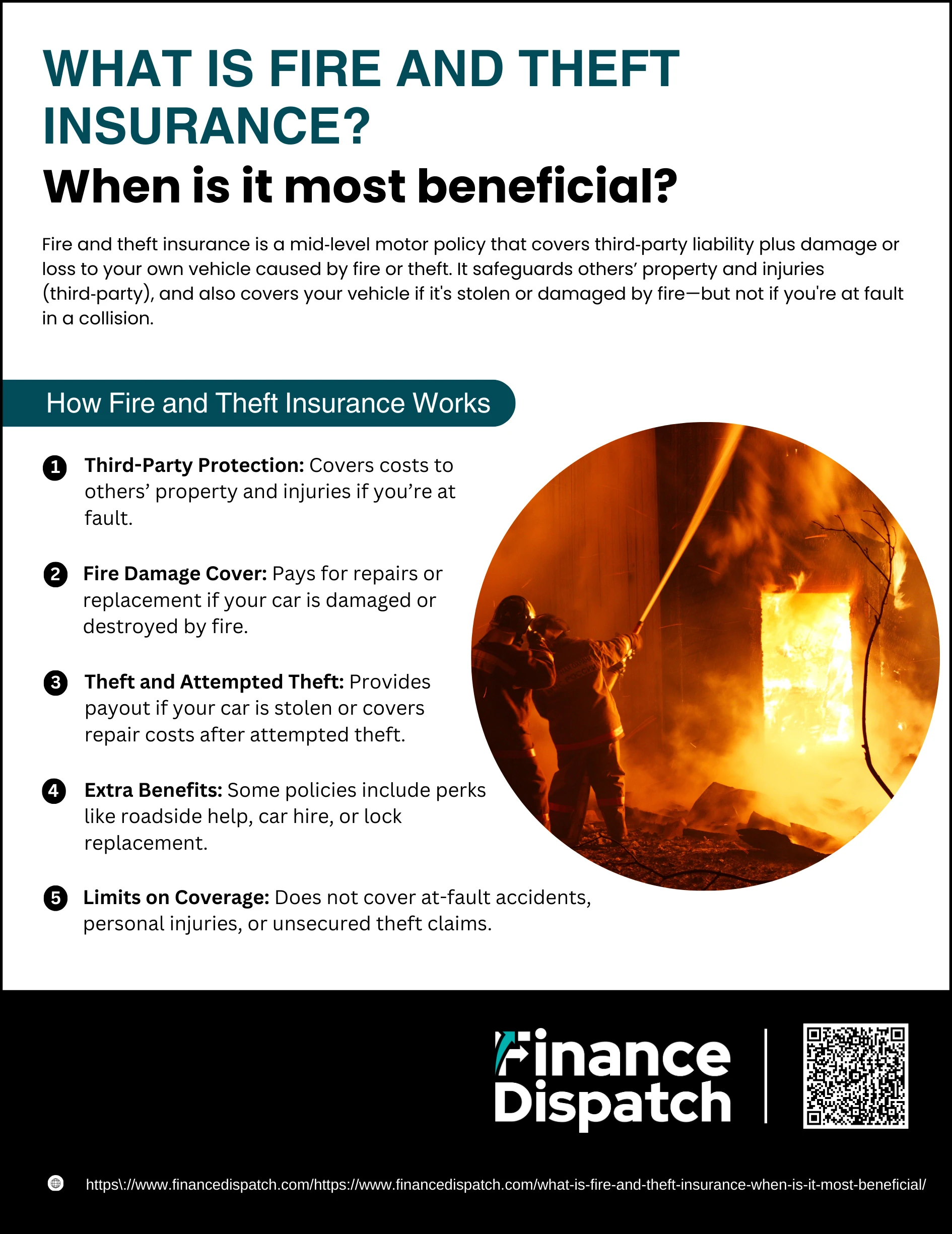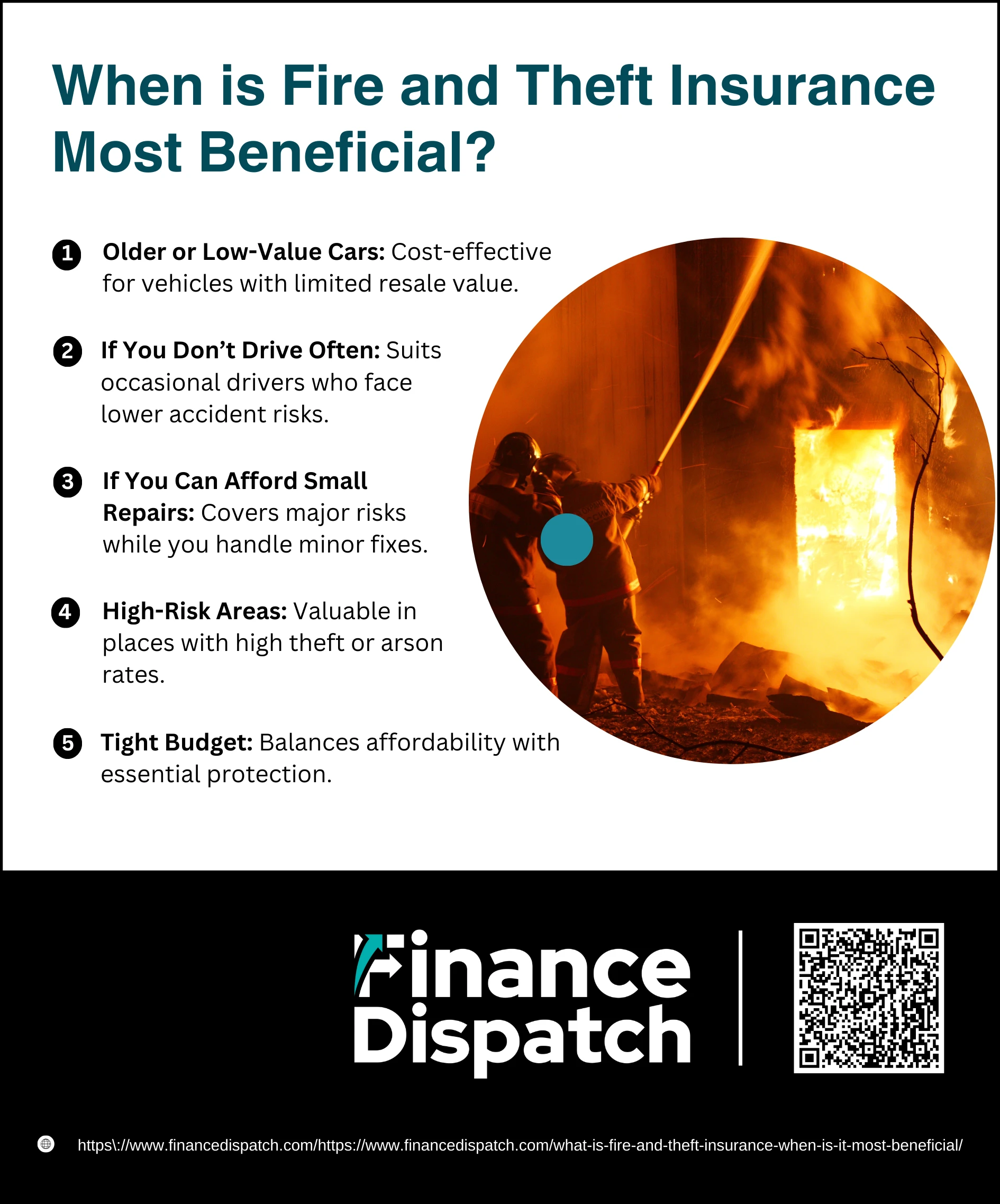When it comes to car insurance, you’ve probably come across terms like third-party, comprehensive, and something in between called third-party, fire and theft insurance. This mid-level cover gives you more protection than the legal minimum but usually costs less than a fully comprehensive policy. It’s designed to cover some of the most common and financially draining risks—like your car being stolen or damaged by fire—while still protecting you if you’re responsible for damage to someone else’s vehicle or property. But here’s the real question: is fire and theft insurance the right choice for you, and under what circumstances does it make the most sense?
What is Fire and Theft Insurance?
Fire and theft insurance, often referred to as third-party, fire and theft (TPFT), is a mid-level car insurance policy that sits between basic third-party only cover and a comprehensive plan. It not only protects you against claims from other people if you cause damage to their vehicle or property but also gives you added security for your own car in two specific situations: if it’s stolen or if it’s damaged by fire. Unlike comprehensive insurance, however, it won’t cover the cost of repairs to your own vehicle if you’re at fault in an accident. This makes TPFT an appealing choice for drivers who want more than the bare minimum of protection but don’t need or can’t justify the cost of full coverage.
 How Fire and Theft Insurance Works
How Fire and Theft Insurance Works
Fire and theft insurance is often described as a “middle ground” between third-party only cover and fully comprehensive insurance. It provides more protection than the minimum required by law, without the higher premiums of comprehensive policies. With this type of cover, you’re protected against liabilities to others and also against two of the most financially damaging risks to your own car: fire and theft. Here’s a closer look at how it works in detail:
1. Third-Party Protection
At its core, fire and theft insurance includes third-party liability cover. This means if you’re at fault in an accident, your insurer will pay for the cost of repairing the other driver’s vehicle or property, as well as any medical expenses or injury compensation. This not only keeps you legally compliant but also protects you from potentially large out-of-pocket expenses.
2. Fire Damage Cover
If your car is damaged by fire, whether accidental (like an electrical fault or engine overheating) or deliberate (such as arson), the insurer will cover the cost of repairs or even a full replacement if the car is written off. This coverage can be a major financial safeguard, as fire damage often leads to total loss of the vehicle.
3. Theft and Attempted Theft
Theft protection is one of the biggest advantages of this policy. If your car is stolen and not recovered, the insurer will typically pay out the value of the vehicle. Even in cases of attempted theft, where damage might occur to locks, windows, or the ignition system, you’ll be covered for repair costs. This helps you avoid paying hefty repair bills from a break-in.
4. Extra Benefits (Depending on Policy)
Some insurers go beyond the basics and include additional perks. These may include cover for stolen or damaged car audio systems, sat-nav devices, or other in-car entertainment systems. In certain cases, you might also find extras such as roadside assistance, hire car availability after theft, or lock replacement. These add-ons vary by provider, so it’s always worth checking the fine print.
5. Limits on Coverage
While fire and theft insurance is helpful, it’s not all-inclusive. If your own car is damaged in an accident you caused, you’ll need to pay for the repairs yourself, as this policy doesn’t cover at-fault collision damage. Similarly, it doesn’t usually include medical expenses for your own injuries or damage to personal belongings inside the vehicle. And if your car was left unlocked or unsecured when stolen, your claim may be denied.
 When is Fire and Theft Insurance Most Beneficial?
When is Fire and Theft Insurance Most Beneficial?
Fire and theft insurance shines in specific situations, especially for drivers who don’t need the full breadth of a comprehensive policy but still want more protection than basic third-party cover. It balances affordability with coverage for major risks, making it ideal for those who want peace of mind without paying top-tier premiums.
1. When Your Car is Older or Low Value
If your car isn’t worth a lot, comprehensive insurance might not be cost-effective because the payout for a total loss may be close to—or even less than—the annual premiums. Fire and theft insurance helps protect against bigger risks like your car being stolen or destroyed by fire, while leaving out the expensive accident cover you may not need for an older, inexpensive vehicle.
2. If You Don’t Drive Often
For drivers who only use their cars occasionally, such as retirees or those who rely mostly on public transport, the likelihood of being involved in an accident is lower. In these cases, a fire and theft policy provides a safety net for rare but costly events like theft or fire damage, without paying the higher cost of comprehensive coverage.
3. When You Can Afford Small Repairs Yourself
Some drivers are handy with repairs or don’t mind paying out-of-pocket for minor accident damage. If that’s you, fire and theft insurance makes sense: it covers the bigger financial shocks like losing your car to theft, while you handle smaller repair costs. This way, you’re not overpaying for a policy that covers risks you’re comfortable managing.
4. If You Live in a High-Risk Area
Living in an area with high rates of car theft, hijacking, or arson makes theft and fire coverage extremely valuable. Even if your car isn’t worth much, the financial loss of replacing it could be significant. A fire and theft policy gives you peace of mind, knowing you’re protected against risks that are statistically more likely where you live.
5. When You’re on a Tight Budget
Not everyone can afford comprehensive insurance, especially younger drivers or those facing budget constraints. Fire and theft insurance acts as a middle option: it ensures you’re not left completely unprotected, while still keeping premiums lower than a fully comprehensive plan. This balance allows you to drive legally and safely without overspending.
What Does It Cover and Not Cover?
Fire and theft insurance gives you peace of mind against some major risks, but like all policies, it has clear limits. It covers your liability to others, fire-related damage, and theft of your vehicle, but it won’t pay out for every situation—especially when it comes to accidents you cause or your personal medical costs. To make things clearer, here’s a breakdown of what is typically included and excluded under this type of insurance:
| Area | Covered | Not Covered |
| Third-Party Liability | Repairs to another person’s car or property if you’re at fault; medical or injury compensation for others. | Your own car repairs or medical costs if you’re injured in the accident. |
| Fire Damage | Repairs or replacement if your car is damaged by accidental fire, electrical fault, or arson. | Damage caused by accidents unrelated to fire, or natural events like storms. |
| Theft/Attempted Theft | Replacement if your car is stolen and not recovered; repairs for break-in damage (e.g., smashed windows, broken locks). | Theft if you left the car unlocked or unsecured. |
| Personal Belongings | Some policies may cover in-car entertainment systems like radios or sat-navs. | Personal items like phones, laptops, or bags inside your vehicle. |
| Extras (Policy-Dependent) | Possible add-ons like roadside assistance, towing costs, lock replacement, or car hire after theft. | Not all insurers offer these, and some high-value cars may be excluded. |
Pros and Cons of Fire and Theft Insurance
Fire and theft insurance is often seen as a middle-ground option between basic third-party cover and comprehensive policies. It gives you some valuable protection without requiring you to pay the highest premiums. However, like any insurance product, it has both strengths and weaknesses that you should weigh carefully before choosing.
Pros of Fire and Theft Insurance
1. Affordable Compared to Comprehensive
One of the biggest advantages is cost. Fire and theft policies are usually priced lower than comprehensive insurance, making them attractive for drivers on a budget. They allow you to stay protected without committing to the higher premiums that come with full coverage.
2. Covers Theft and Fire Risks
Theft and fire are among the most financially devastating risks for car owners. With this policy, you’re covered if your car is stolen, damaged in an attempted theft, or destroyed by fire. This safeguard ensures you don’t face the heavy burden of replacing or repairing your vehicle entirely out of pocket.
3. Includes Third-Party Liability
Like all legally required policies, fire and theft insurance covers your liability to other people. That means if you cause damage to someone else’s vehicle or property, or if another person is injured in an accident you’re responsible for, your insurer takes care of those costs.
4. Extra Benefits Available
Depending on your provider, you may have access to optional extras. These could include cover for car audio systems or sat-navs, roadside assistance, hire car options after theft, or replacement locks. While not always included, these add-ons can give you extra peace of mind.
5. Good Fit for Older Cars
If your vehicle is older or has a lower resale value, comprehensive insurance might not be worth the cost. Fire and theft insurance offers protection against the biggest risks without forcing you to overpay for cover that may exceed your car’s actual value.
Cons of Fire and Theft Insurance
1. No Cover for At-Fault Accidents
The biggest drawback is that if you cause an accident, your own car isn’t covered. You’ll have to pay for repairs or replacement yourself, which can be a major expense. This limitation makes the policy less appealing for drivers who want full protection.
2. Limited Add-Ons
Compared to comprehensive policies, fire and theft cover generally comes with fewer optional extras. You may not get benefits like full roadside recovery, windscreen cover, or extensive personal belongings protection unless you pay extra—if they’re offered at all.
3. Not Ideal for High-Value Cars
Drivers of newer or expensive vehicles may find that this policy doesn’t offer enough protection. Since it doesn’t cover accidental damage, owners of high-value cars could face huge losses if they’re involved in a collision. Comprehensive insurance is usually the safer choice in these cases.
4. Higher Out-of-Pocket Costs
Even though premiums may be lower, you could end up paying more in the long run if you’re involved in an at-fault accident. With no cover for your own vehicle damage, you’re responsible for repairs or replacements, which can quickly outweigh any premium savings.
5. Can Sometimes Cost More
Interestingly, fire and theft insurance isn’t always the cheapest option. In some markets, insurers have found that higher-risk drivers often choose this type of policy, leading to increased claims. As a result, premiums can sometimes be higher than comprehensive cover, which surprises many drivers.
Conclusion
Fire and theft insurance offers a balanced option for drivers who want more than just the legal minimum but don’t necessarily need the full protection of a comprehensive policy. It covers the major risks of theft and fire while ensuring you’re still protected against third-party claims, making it especially useful for older or low-value cars, budget-conscious drivers, or those who don’t use their vehicle often. However, it’s not without limitations—at-fault accident damage and personal medical costs aren’t included, which means it isn’t the right fit for everyone. The key is to weigh your car’s value, your driving habits, and your budget, then compare quotes carefully. By doing so, you’ll be able to decide whether fire and theft insurance is the most beneficial choice for your needs.



